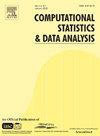包含生长曲线的随机SIR模型的推论
IF 1.6
3区 数学
Q3 COMPUTER SCIENCE, INTERDISCIPLINARY APPLICATIONS
引用次数: 0
摘要
提出了一种易感-感染-去除随机模型,该模型通过易感种群和感染种群动力学中的两个独立布朗运动引入随机性。为了解释易感群体的自然进化,考虑了一个生长函数,其中大小受个体出生和死亡的影响。利用拟极大似然估计(Quasi Maximum Likelihood Estimation, QMLE)方法解决了该模型的推理问题。所得到的非线性系统可以通过迭代过程进行数值求解。本文还提供了一种获得这些方法通常需要的初始解的技术。最后,对Gompertz曲线、Logistic曲线和Bertalanffy曲线这三种著名的生长函数进行了仿真研究。评估了所涉及参数的初始估计的性能,并评估了所提出方法的优点。本文章由计算机程序翻译,如有差异,请以英文原文为准。
Inference on a stochastic SIR model including growth curves
A Susceptible-Infected-Removed stochastic model is presented, in which the stochasticity is introduced through two independent Brownian motions in the dynamics of the Susceptible and Infected populations. To account for the natural evolution of the Susceptible population, a growth function is considered in which size is influenced by the birth and death of individuals. Inference for such a model is addressed by means of a Quasi Maximum Likelihood Estimation (QMLE) method. The resulting nonlinear system can be numerically solved by iterative procedures. A technique to obtain the initial solutions usually required by such methods is also provided. Finally, simulation studies are performed for three well-known growth functions, namely Gompertz, Logistic and Bertalanffy curves. The performance of the initial estimates of the involved parameters is assessed, and the goodness of the proposed methodology is evaluated.
求助全文
通过发布文献求助,成功后即可免费获取论文全文。
去求助
来源期刊

Computational Statistics & Data Analysis
数学-计算机:跨学科应用
CiteScore
3.70
自引率
5.60%
发文量
167
审稿时长
60 days
期刊介绍:
Computational Statistics and Data Analysis (CSDA), an Official Publication of the network Computational and Methodological Statistics (CMStatistics) and of the International Association for Statistical Computing (IASC), is an international journal dedicated to the dissemination of methodological research and applications in the areas of computational statistics and data analysis. The journal consists of four refereed sections which are divided into the following subject areas:
I) Computational Statistics - Manuscripts dealing with: 1) the explicit impact of computers on statistical methodology (e.g., Bayesian computing, bioinformatics,computer graphics, computer intensive inferential methods, data exploration, data mining, expert systems, heuristics, knowledge based systems, machine learning, neural networks, numerical and optimization methods, parallel computing, statistical databases, statistical systems), and 2) the development, evaluation and validation of statistical software and algorithms. Software and algorithms can be submitted with manuscripts and will be stored together with the online article.
II) Statistical Methodology for Data Analysis - Manuscripts dealing with novel and original data analytical strategies and methodologies applied in biostatistics (design and analytic methods for clinical trials, epidemiological studies, statistical genetics, or genetic/environmental interactions), chemometrics, classification, data exploration, density estimation, design of experiments, environmetrics, education, image analysis, marketing, model free data exploration, pattern recognition, psychometrics, statistical physics, image processing, robust procedures.
[...]
III) Special Applications - [...]
IV) Annals of Statistical Data Science [...]
 求助内容:
求助内容: 应助结果提醒方式:
应助结果提醒方式:


